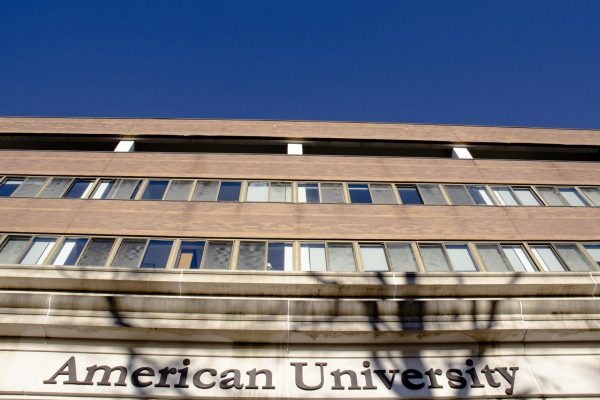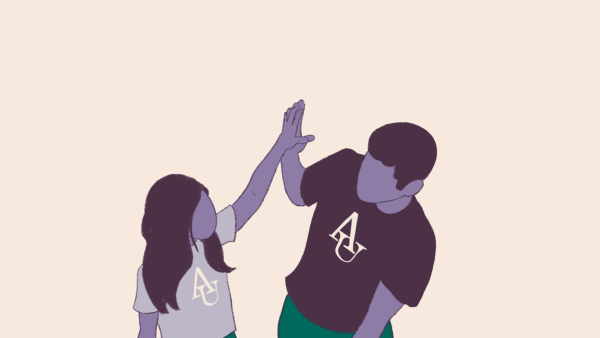Inclusive Excellence: Where it comes from and where it’s going
In the academic years 2014-2016, there were 15 offenses at American University that were characterized as hate crimes, according to AU’s latest annual security report. After the election of AU’s first black female student government president in the spring of 2017, bananas hung in nooses sparked outrage on campus and made national headlines. In the fall of 2017, the campus was vandalized with posters of confederate flags.
On Jan. 30, 2018 AU President Sylvia Burwell launched the Plan for Inclusive Excellence, part of a $60 million annual diversity initiative, following the incident of confederate flag posters.
“Inclusive excellence is about how do we actually create a new normal in this institution,” Amanda Taylor, Assistant Vice President of Diversity, Equity, and Inclusion at American University said. “Most immediately [the Plan for Inclusive Excellence] comes from the acts of race hate and bias on the campus in fall 2017.”
This is not the first time such inclusive work has been done on campus, according to Taylor.
Similar programs, including the newly required freshman American University Experience (AUx) class that discusses race and bias, have been piloted for years. However, these separate efforts are most effective when aligned under a broader strategic plan, Taylor said.
“The Plan for Inclusive Excellence is a campus-wide initiative, meaning there has to be actors at every part of the institution engaged in the work, not just one office,” Taylor said.
But what exactly does “Inclusive Excellence” mean? The Association of American Colleges and Universities’ (AACU) Inclusive Excellence Plan lists four elements colleges need to have for inclusive excellence. These include offering the courses best fit for the university; establishing an accessible, academically-challenging environment; highlighting and appreciating cultural differences; and fostering a community welcoming of its diversity.
“Inclusive Excellence is a framework from AACU that’s used by many institutions,” Taylor said. “It’s a way of ensuring we get to the systematic and structural change.”
The AACU Plan was created after the use of racial quotas was ruled unconstitutional by the Supreme Court in 2003, since it violated the Equal Protection Clause of the 14th amendment.
The AACU Plan aimed to promote diversity while still remaining selective in admissions. The danger of traditional methods of selection like standardized test scores, GPA, and extracurriculars, is that they overlook candidates who, because of socio-economic conditions, cannot fit this definition of success and thus have been historically underrepresented, according to the AACU plan.
While immediate actions, like including people of color in admissions brochures, give the appearance of diversity, the AACU Plan cautions that such changes are surface-level and should not become substitutes for implementing deeper, value based-changes in the school.
“Admissions is really key,” Taylor said. “An important question is who gets to the door in this uneven environment that folks have to navigate, and so the key for us right now is partnerships.”
One partnership has been a Dual Enrollment Program between the AU School of Education and DC Public Schools that welcomes 12th-grade students to take college-level education classes to prepare a new generation of diverse teachers.
The AACU plan explains that the most visible parts of a university are its images, such as brochures aimed at prospective students, parents and visitors. However, the deepest parts are their core beliefs and values. These values make up the structure of every office, facilitate the communication between students and administration and dictate how the school admits new students.
“Diversity is about having diverse people and ideas in your organization at every level, and that’s key,” Taylor said. “But inclusion is about how do we create a new normal in this institution whereby ideas and perspectives of all individuals, with specific attention to folks whose voices have historically been structured as marginalized, are actually deeply engaged and valued, which is different than having people who look different.”
Changing AU’s values can be achieved by creating bureaucratic roles that are powerful enough to have an impact on curriculum, campus climate, and demographic makeup of the student, staff, and faculty populations, according to the AACU plan.
One way AU’s Inclusive Excellence Plan has done this is by creating the Student Advisory Council (SAC) to include the opinions of students about campus culture. The SAC conducts bi-weekly meetings where members discuss the goals of the President’s Council on Diversity and Inclusion (PCDI) and concerns from the student body, and they act as the “ears” of Fanta Aw, Vice President of Campus Life, according to Rafael Cestero, co-chair of SAC.
Aaliyah Charania, a SAC member, said SAC typically receives the concerns of minority groups on campus, such as the South Asian Student Union or the NAACP. They try to address those concerns by seeking additional training for faculty and staff, but more importantly, make it mandatory as well.
SAC tries to prevent hate crimes by catching problematic behavior from students before incidents can occur and taking proactive measures, according to Charania.
“It’s constantly happening, and it just got caught on camera. I don’t think these incidences are random,” Charania said. “I think it’s the culture of the campus, and that’s why they put [the SAC] here to help change the culture of the campus. If the campus culture shifted, then incidents won’t happen as often because students won’t see it as an acceptable form of behavior.”
However, Aaliyah and other SAC members believe that change will not occur for a while.
“Well this is our first year, and change is a really slow process. But we’ve set the groundwork for things that will happen later,” Charania said. “For instance, we met with someone who creates curriculum for professors on how to train them for pedagogy or how to be more aware of biases in classrooms.”
Eric Brock Jr., another SAC member, said that instituting change does not come from having a seat on the SAC, but rather being a social organizer and committing every day to making the change.
“It’s really new, and it hasn’t existed for a long time, so we’re looking at what we want to do and who’s involved,” Brock said. “It’s not only about being on the council but what you’re doing individually beyond the council. If you’re expecting to become an organizer on the council, then you shouldn’t be on the council. You should have already been an organizer.”
During Inclusive Excellence training from Taylor, some RAs were not satisfied with the work that the PCDI has done on cultivating a more inclusive campus climate.
“A lot of what’s going on is buzzwords, but what are you actually doing to address and change people’s way of thought?” said Alyssa Bailey, an RA and AU Ambassador.
Taylor and SAC members would like to see everyone have a more inclusive mindset so that their roles are no longer needed.
“I think we’ll know we’re there when we don’t need Inclusive Excellence Plan anymore because everyone is doing Inclusive Excellence,” Taylor said. “And we’ll know when we have a new normal when we have sense of belonging that doesn’t have gaps by any social identity, perspective, or political ideology.”







